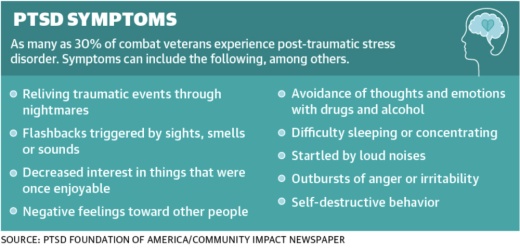David Maulsby, executive director of the PTSD Foundation of America, said crisis line activity has increased drastically since Taliban forces took control of Afghanistan’s capital in mid-August.
The Cy-Fair-based organization helps veterans and their families heal from the effects of combat-related post-traumatic stress and to help lower the veteran suicide rate.
Maulsby said about 7,300 military members were killed in Iraq and Afghanistan, but more than 30,000 veterans from Iraq and Afghanistan have died by suicide upon returning home following their service.
Many veterans struggle with their sense of purpose and identity when transitioning back to civilian life, and Maulsby said those experiencing PTSD carry guilt associated with what they saw and experienced.
“When they came home, they couldn’t rewire their brain back to where we are,” he said. “Many of them felt the lack of ability to change some of the things that they saw, [which] carried an awful lot of weight. And then they come home to a society that’s basically forgotten about the fact that we even had people at war.”
The PTSD Foundation of America has an interim housing facility called Camp Hope, which offers a safe space for veterans from across the country to heal through group lessons and support sessions, individual mentoring and life skills needed to transition back to society.
Maulsby said Camp Hope typically has 60-75 residents at any given time, but that increased to around 95 when the COVID-19 pandemic hit. He said this uptick can partially be attributed to the added stress, anxiety and isolation brought on by the pandemic.
However, VA hospitals closed their doors at the start of the pandemic to anything other than a physical emergency, so veterans in mental health crises ended up in emergency rooms and psychiatric facilities instead.
“The VA has opened some services back up but not all, so there are still guys that are getting no’s when they contact the VA,” Maulsby said. “It’s still an issue in our country.”
The PTSD Foundation of America also runs support groups across the U.S. and added Zoom support group options in the wake of COVID-19. Maulsby said while the organization did not replace face-to-face sessions, this helped it reach people it may not have otherwise.
When it comes to current military service members, the U.S. Department of Defense reported 580 members died by suicide in 2020—up from 504 in 2019. Officials said while suicide rates increased in 2020, they did not see a significant enough statistical change over 2019 and 2018 rates to definitively determine the uptick was related to the COVID-19 pandemic.
Service members and their loved ones can call 800-273-8255, text 838255 or visit www.veteranscrisisline.net for support 24 hours a day.





